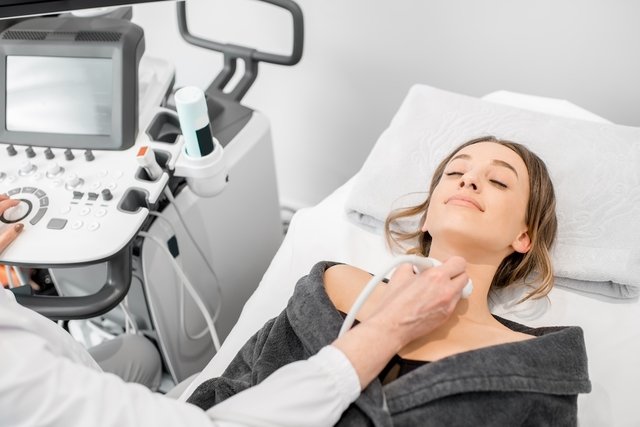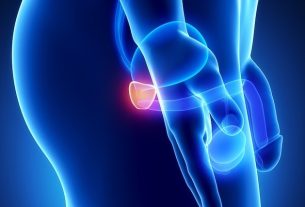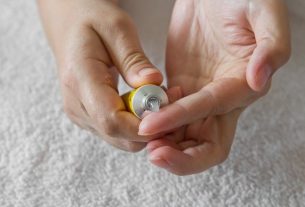A hypoechoic, or hypoechoic, nodule is one that is visualized through imaging tests, such as ultrasound, and which indicates a lesion that is denser than the surrounding tissues, generally formed by liquids, fat or tissues, for example, that measure more than 1 cm in diameter and are generally rounded and lump-like.
A nodule can appear on the skin, subcutaneous tissue or any other organ in the body, and it is common to be detected in the breast, thyroid, ovaries, uterus, liver, pancreas, testicles, kidneys, lymph nodes or joints, for example. Sometimes, when superficial, they can be palpated, while in many cases, only ultrasound or tomography exams can detect them.
A hypoechoic nodule may indicate a benign or malignant lesion, and the result of the examination must be interpreted by the doctor, who may request other diagnostic tests to confirm the type of lesion, such as computed tomography, magnetic resonance imaging or biopsy, for example. Find out how a biopsy is performed.

Characteristics of the hypoechoic nodule
Hypoechoic nodules may have the following characteristics:
- Cyst: appears when the nodule has liquid content inside. Check out the main types of cyst and when they can be serious;
- Solid: when its content contains solid or thick structures, such as tissues, or a liquid that has a considerable density, with many cells or other elements inside;
- Mixed: can arise when the same nodule encompasses liquid and solid structures in its content.
Hypoechoic nodules generally appear on ultrasound examination as masses that are darker than the surrounding tissues, which, because they are denser, reflect fewer ultrasound sound waves.
When is the nodule serious?
Generally, the nodule presents characteristics that may indicate that it is serious or not, however, there is no rule for everyone, and a doctor’s evaluation is necessary to observe not only the result of the examination, but also the physical examination, presence of symptoms or risks that the person may present.
Some characteristics that may raise suspicion of the nodule vary according to the organ in which it is located, and may be:
1. Hypoechoic nodule in the breast
Most of the time, the lump in the breast is not a concern, and it is common for benign lesions such as fibroadenoma, abscess, mastitis or simple cyst to appear, for example. Cancer is usually suspected when there are changes in the shape or size of the breast, in the presence of a family history or when the nodule presents characteristics of malignancy, such as being hard, attached to neighboring tissues, having irregular edges or when it has many blood vessels. , for example.
However, if a breast tumor is suspected, the doctor will recommend a puncture or biopsy to determine the diagnosis. See more about how to know if the breast lump is malignant.
2. Hypoechoic thyroid nodule
The fact that it is hypoechogenic increases the chances of malignancy in a thyroid nodule, however, this characteristic alone is not enough to determine whether it is cancer or not, and medical evaluation is necessary.
Most of the time, the tumor is usually investigated with puncture when it reaches more than 1 cm in diameter, or 0.5 cm when the nodule has characteristics of malignancy, such as hypoechoic nodule, presence of microcalcifications, enlargement of blood vessels, infiltration in the neighboring tissues or when it is taller than it is wide in cross-sectional view.
The nodules should also be punctured in people at high risk for malignancy, such as those who were exposed to radiation in childhood, who have genes associated with cancer or who have a personal or family history of cancer, for example. However, it is important that the doctor evaluates each case individually, as there are specificities and the need to calculate the risk or benefit of the procedures in each situation.
Find out how to identify a thyroid nodule, what tests to take and how to treat it.
3. Hypoechoic nodule in the liver
Liver nodules have variable characteristics, therefore, the presence of a hypoechoic nodule is not enough to indicate whether it is benign or malignant, and the doctor must carry out an evaluation in more detail, according to each case, to determine.
Generally, the nodule in the liver is investigated for the presence of malignancy with imaging tests, such as tomography or resonance, whenever it is larger than 1 cm or when it shows constant growth or changes in appearance. In some cases, the doctor may recommend a biopsy to confirm whether or not the nodule is serious. Find out when a liver biopsy is indicated and how it is done.
Is a hypoechoic nodule cancer?
Being hypoechoic does not confirm whether the nodule is cancer or not, but can only indicate characteristics of the lesion, as in the ultrasound examination the word “echogenicity” only indicates the ease with which ultrasound signals pass through the body’s structures and organs. Thus, hyperechoic structures tend to have a lower density, while hypoechoic or anechoic structures have a higher density.
Some characteristics of the hypoechoic nodule that may indicate cancer are:
- Irregular shape, edges or contour;
- Presence of branches, as if they were tentacles or roots;
- Presence of blood vessels around the nodule;
- Height greater than width;
- Different tones in ultrasound;
- Shape not oval or rounded.
In the presence of malignant characteristics, the doctor normally recommends other tests to investigate and diagnose the type of nodule and whether it is a tumor, such as computed tomography, magnetic resonance imaging, mammography or biopsy, for example.
How the treatment is carried out
The hypoechoic nodule does not always need to be removed as, in most cases, it is benign and only requires observation. The doctor will determine how frequently the nodule will be monitored, with tests such as ultrasound or tomography, for example, which can be every 3 months, 6 months or 1 year.
However, if the nodule begins to present characteristics suspicious of malignancy, such as rapid growth, adherence to neighboring tissues, changes in characteristics or even when it becomes very large or causes symptoms, such as pain or compression of nearby organs, it is recommended to perform a a biopsy, puncture or surgery to remove the nodule. Find out how surgery to remove a breast lump is performed and what recovery is like.




